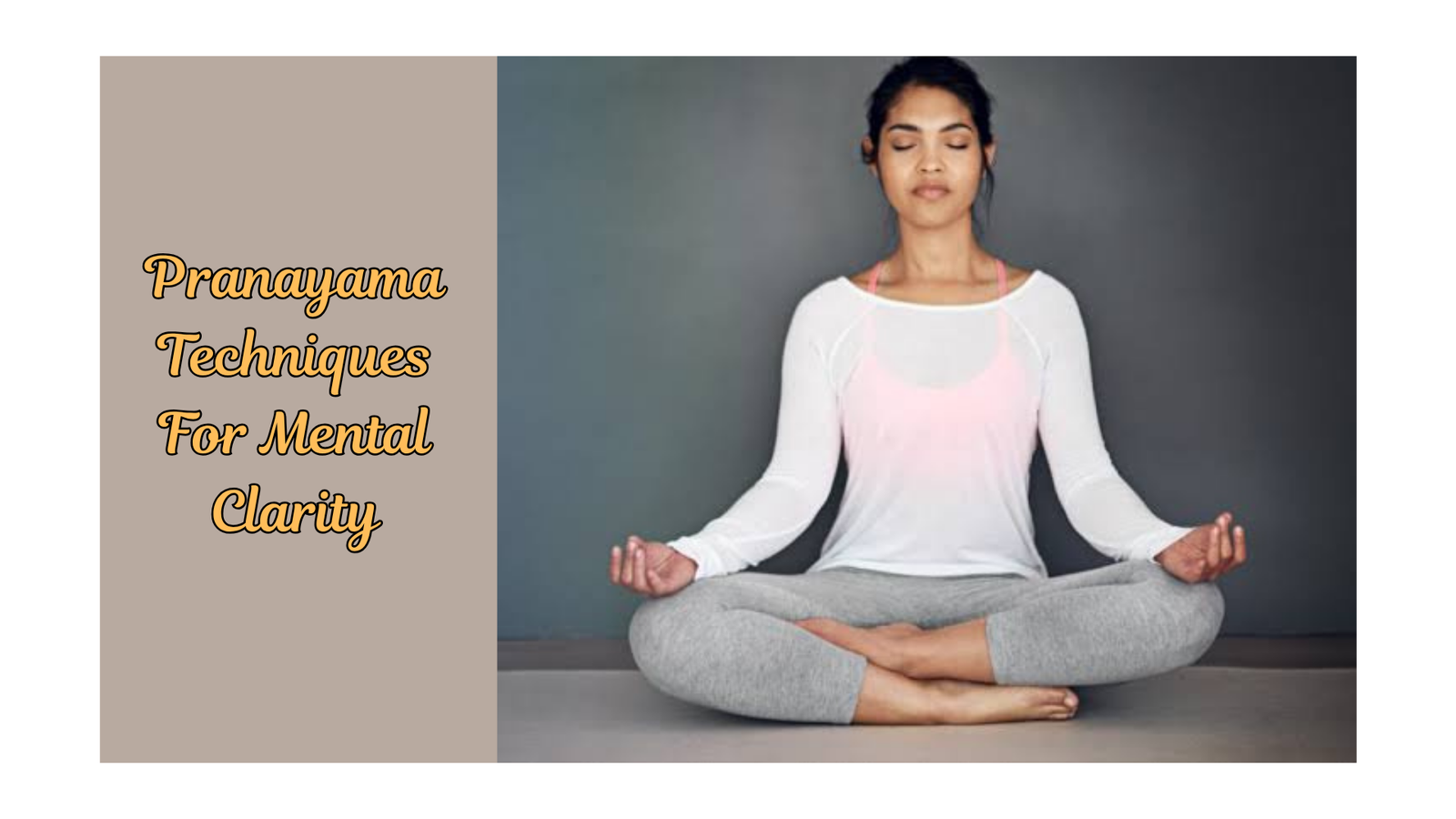Best 6 Pranayama Techniques for Mental Clarity
In today’s fast-paced world, achieving mental clarity can feel like chasing a mirage. With distractions, stress, and an endless stream of information clouding the mind, it becomes essential to turn inward and reconnect with our breath.
By consciously regulating the breath, Pranayama helps calm the nervous system, clear mental fog, and bring clarity to the mind. Whether you’re dealing with stress, anxiety, decision fatigue, or simply seeking to enhance your focus, these six powerful Pranayama techniques could be your gateway to inner peace and clarity.
Let’s explore six Pranayama techniques for mental clarity, their benefits, how to practice them, and tips to integrate them into your daily life.
What Is Pranayama?
Pranayama is a Sanskrit word combining “Prana” (life force or vital energy) and “Ayama” (extension or control). In yogic traditions, breath is not just air; it is a vital life force that governs physical, emotional, and mental wellbeing.
Pranayama techniques involve structured breathing exercises that help balance the energy channels (nadis), calm the mind, and improve concentration. Regular practice enhances oxygenation, reduces stress hormones, and improves brain function, making it an ideal tool for achieving mental clarity.
Why Pranayama for Mental Clarity?
- While many techniques promote mental health, Pranayama stands out because it:
- Directly affects the autonomic nervous system
- Improves oxygen supply to the brain
- Reduces stress, anxiety, and negative emotions
- Promotes mindfulness and present-moment awareness
- Enhances memory, focus, and cognitive function.
6 Pranayama Techniques For Mental Clarity
Now, let’s dive into the six most effective Pranayama techniques for mental clarity and wisdom.
1. Nadi Shodhana (Alternate Nostril Breathing)

Nadi Shodhana, or alternate nostril breathing, is known for balancing the two hemispheres of the brain and calming the nervous system. It removes energy blockages and helps you feel centered.
How to Practice:
1. Sit comfortably with your spine straight.
2. Use your right thumb to close your right nostril.
3. Inhale slowly through the left nostril.
4. Close the left nostril with your ring finger and release the right nostril.
5. Exhale through the right nostril.
6. Inhale through the right nostril, then switch and exhale through the left.
7. This completes one round. Practice 5–10 rounds.
Benefits for Mental Clarity:
Balances left and right brain activity
Reduces anxiety and mental restlessness
Enhances cognitive function and emotional stability
2. Bhramari (Bee Breath)

Bhramari Pranayama involves producing a humming sound that resembles a bee. This vibration calms the mind and stimulates the vagus nerve, a key player in maintaining mental health.
How to Practice:
1. Sit in a quiet space with your eyes closed.
2. Place your index fingers gently on your ears.
3. Inhale deeply.
4. As you exhale, make a gentle humming sound like a bee.
5. Focus on the sound vibrations.
6. Practice 5–7 rounds.
Benefits for Mental Clarity:
Relieves stress, anxiety, and anger
Induces deep relaxation and improved concentration
Calms the thought process and enhances inner awareness
3. Anulom Vilom (Controlled Alternate Nostril Breathing)

Often confused with Nadi Shodhana, Anulom Vilom is a type of alternate nostril breathing with more emphasis on control and rhythm. It’s excellent for calming a busy mind.
How to Practice:
1. Sit in a comfortable position with a straight spine.
2. Close the right nostril and inhale through the left (count to 4).
3. Close both nostrils and hold the breath (count to 8).
4. Open the right nostril and exhale (count to 8).
5. Inhale through the right (count to 4), hold (count to 8), and exhale through the left (count to 8).
6. Practice 5–10 rounds.
Benefits for Mental Clarity:
Improves focus and memory
Calms emotional turbulence
Regulates mental energy
4. Kapalabhati (Skull-Shining Breath)

Kapalabhati is an energizing and detoxifying breathing technique. It involves forceful exhalations and passive inhalations that cleanse the mind and stimulate brain function.
How to Practice:
1. Sit with your spine erect.
2. Inhale normally.
3. Exhale forcefully through the nose while pulling the belly inward.
4. Allow passive inhalation.
5. Repeat for 30 strokes. Gradually increase to 100 over time.
6. Rest and breathe normally between rounds.
Caution: Avoid if you have high blood pressure or heart issues.
Benefits for Mental Clarity:
Stimulates the brain and nervous system
Removes mental sluggishness
Sharpens awareness and boosts energy levels
5. Ujjayi Pranayama (Victorious Breath)

Ujjayi involves slightly constricting the throat while breathing, creating an oceanic sound. It enhances focus and helps anchor the mind during stressful situations.
How to Practice:
1. Sit comfortably and close your eyes.
2. Inhale deeply through the nose, constricting the throat slightly.
3. Exhale through the nose with the same throat constriction, producing a soft “haaaa” sound.
4. Keep the breath smooth and rhythmic.
5. Practice for 5–10 minutes.
Benefits for Mental Clarity:
Improves concentration and memory
Reduces anxiety and insomnia
Helps maintain emotional equilibrium
6. Sheetali Pranayama (Cooling Breath)

Sheetali involves inhaling through a curled tongue, which cools the body and mind. It’s ideal when mental heat (stress, irritation, or burnout) is present.
How to Practice:
1. Sit comfortably.
2. Curl your tongue lengthwise and stick it out slightly.
3. Inhale deeply through the curled tongue.
4. Close your mouth and exhale through the nose.
5. Repeat 5–10 times.
Note: If you can’t curl your tongue, try Sheetkari – inhale through the teeth with lips parted.
Benefits for Mental Clarity:
Cools the mind and reduces anger or frustration
Soothes mental fatigue
Improves emotional regulation
How to Integrate These Pranayama Techniques into Your Routine
Incorporating these practices into your daily life doesn’t require hours of free time. Here’s a practical guide to help you stay consistent:
Morning Routine (10–15 Minutes)
Kapalabhati (2 minutes): Kickstart your brain.
Anulom Vilom (5 minutes): Balance and focus.
Ujjayi (5 minutes): Set a calm, alert tone for the day.
Midday Break (5–10 Minutes)
Nadi Shodhana (5 minutes): Re-center your energy during work.
Sheetali (optional): Use when feeling stressed or overheated.
Night Routine (10 Minutes)
Bhramari (5 minutes): Calm your nervous system.
Anulom Vilom or Ujjayi (5 minutes): Prepare for deep sleep.
Tips for Better Results
Practice on an empty stomach or at least 2 hours after a meal.
Sit in a quiet place with minimal distractions.
Combine Pranayama with light yoga or meditation.
Stay consistent – even 10 minutes a day yields results over time.
Listen to your body and never force your breath.
Additional Benefits of Pranayama Beyond Mental Clarity
While our focus is mental clarity, it’s worth noting that these Pranayama techniques offer a wide range of other health benefits, including:
Improved lung capacity and respiratory health
Enhanced digestion and metabolic efficiency
Detoxification of internal organs
Lowered blood pressure and heart rate
Better emotional balance and self-awareness
Improved immunity and overall vitality
Pranayama is more than just a tool for focus—it’s a complete system for holistic wellness.
Also read: How To Lower Blood Pressure Without Medication
Scientific Backing: What Research Says
Several modern studies support the effectiveness of Pranayama for mental health:
A 2013 study published in the Journal of Clinical Psychology found that Bhramari Pranayama significantly reduced symptoms of anxiety and improved attention.
Research in the International Journal of Yoga (2018) highlighted that regular Anulom Vilom practice leads to improved memory and mental performance.
A study published in Frontiers in Human Neuroscience (2020) showed that breath-based interventions can improve emotional regulation and executive functioning.
The science is catching up with what yogis have known for centuries—your breath is the key to your brain.
Mental clarity isn’t just about having fewer thoughts—it’s about having focused, meaningful thoughts. With regular practice of these six Pranayama techniques—Nadi Shodhana, Bhramari, Anulom Vilom, Kapalabhati, Ujjayi, and Sheetali—you can declutter your mind, reduce mental fatigue, and invite greater clarity, peace, and purpose into your life.
The beauty of Pranayama lies in its simplicity. All you need is your breath and a few quiet moments. Begin with what feels comfortable, be consistent, and witness the transformation unfold—one breath at a time.
Disclaimer
The information provided in this article is for educational and informational purposes only and is not intended as a substitute for professional medical advice, diagnosis, or treatment. Always consult your physician or a qualified healthcare provider before beginning any new exercise, breathing practice, or wellness routine, especially if you have pre-existing health conditions such as respiratory issues, heart problems, or high blood pressure. Practice Pranayama techniques gently and mindfully, and stop immediately if you feel dizzy, uncomfortable, or unwell.
FAQs
Q: Can beginners practice Pranayama safely?
A: Yes. Most techniques like Nadi Shodhana, Bhramari, and Anulom Vilom are beginner-friendly. Always start slowly and seek guidance if needed.
Q: How long should I practice Pranayama for mental clarity?
A: Even 10–15 minutes daily can bring noticeable results within a few weeks. Consistency is key.
Q: When is the best time to do Pranayama?
A: Early morning or before meditation is ideal. However, mid-day or evening practices can also be beneficial.
Q: Are there any side effects of Pranayama?
A: When done correctly, Pranayama is safe. Avoid overexertion, especially in techniques like Kapalabhati or breath retention.




